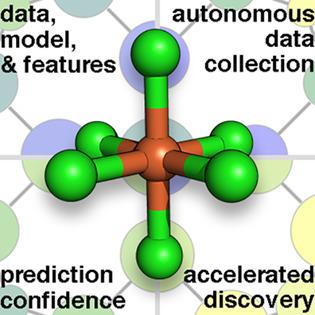当前位置:
X-MOL 学术
›
WIREs Comput. Mol. Sci.
›
论文详情
Our official English website, www.x-mol.net, welcomes your
feedback! (Note: you will need to create a separate account there.)
Making machine learning a useful tool in the accelerated discovery of transition metal complexes
Wiley Interdisciplinary Reviews: Computational Molecular Science ( IF 16.8 ) Pub Date : 2019-08-02 , DOI: 10.1002/wcms.1439 Heather J. Kulik 1
Wiley Interdisciplinary Reviews: Computational Molecular Science ( IF 16.8 ) Pub Date : 2019-08-02 , DOI: 10.1002/wcms.1439 Heather J. Kulik 1
Affiliation

|
As machine learning (ML) has matured, it has opened a new frontier in theoretical and computational chemistry by offering the promise of simultaneous paradigm shifts in accuracy and efficiency. Nowhere is this advance more needed, but also more challenging to achieve, than in the discovery of open‐shell transition metal complexes. Here, localized d or f electrons exhibit variable bonding that is challenging to capture even with the most computationally demanding methods. Thus, despite great promise, clear obstacles remain in constructing ML models that can supplement or even replace explicit electronic structure calculations. In this article, I outline the recent advances in building ML models in transition metal chemistry, including the ability to approach sub‐kcal/mol accuracy on a range of properties with tailored representations, to discover and enumerate complexes in large chemical spaces, and to reveal opportunities for design through analysis of feature importance. I discuss unique considerations that have been essential to enabling ML in open‐shell transition metal chemistry, including (a) the relationship of data set size/diversity, model complexity, and representation choice, (b) the importance of quantitative assessments of both theory and model domain of applicability, and (c) the need to enable autonomous generation of reliable, large data sets both for ML model training and in active learning or discovery contexts. Finally, I summarize the next steps toward making ML a mainstream tool in the accelerated discovery of transition metal complexes.
中文翻译:

使机器学习成为加速发现过渡金属配合物的有用工具
随着机器学习(ML)的成熟,它提供了在准确性和效率上同时发生范式转换的希望,从而在理论和计算化学领域开辟了新的领域。在发现开壳过渡金属络合物方面,没有比这更需要取得进步,而且实现起来也更具挑战性的了。在这里,本地化的d或f电子表现出可变键,即使使用最需要计算量的方法也很难捕获。因此,尽管前景广阔,但是在构建可以补充甚至取代显式电子结构计算的ML模型中仍然存在明显的障碍。在本文中,我概述了在过渡金属化学中建立ML模型的最新进展,包括能够以量身定制的方式对一系列性能达到亚kcal / mol精度,发现和枚举大型化学空间中的络合物,以及通过分析功能重要性来揭示设计机会。我将讨论在开式过渡金属化学中实现ML必不可少的独特考虑因素,其中包括(a)数据集大小/多样性,模型复杂性和表示形式选择之间的关系,(b)对适用性的理论和模型领域进行定量评估的重要性,以及(c)需要为ML模型训练以及在主动学习或发现背景下自动生成可靠的大型数据集。最后,我总结了使ML成为加速发现过渡金属配合物的主流工具的下一步。
更新日期:2019-08-02
中文翻译:

使机器学习成为加速发现过渡金属配合物的有用工具
随着机器学习(ML)的成熟,它提供了在准确性和效率上同时发生范式转换的希望,从而在理论和计算化学领域开辟了新的领域。在发现开壳过渡金属络合物方面,没有比这更需要取得进步,而且实现起来也更具挑战性的了。在这里,本地化的d或f电子表现出可变键,即使使用最需要计算量的方法也很难捕获。因此,尽管前景广阔,但是在构建可以补充甚至取代显式电子结构计算的ML模型中仍然存在明显的障碍。在本文中,我概述了在过渡金属化学中建立ML模型的最新进展,包括能够以量身定制的方式对一系列性能达到亚kcal / mol精度,发现和枚举大型化学空间中的络合物,以及通过分析功能重要性来揭示设计机会。我将讨论在开式过渡金属化学中实现ML必不可少的独特考虑因素,其中包括(a)数据集大小/多样性,模型复杂性和表示形式选择之间的关系,(b)对适用性的理论和模型领域进行定量评估的重要性,以及(c)需要为ML模型训练以及在主动学习或发现背景下自动生成可靠的大型数据集。最后,我总结了使ML成为加速发现过渡金属配合物的主流工具的下一步。











































 京公网安备 11010802027423号
京公网安备 11010802027423号